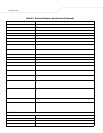
MC50 User GuideGL-2
AirBEAM
®
Smart Client
AirBEAM® Smart Client is part of Symbol’s AirBEAM® suite,
which also includes AirBEAM® Safe and AirBEAM® Manager. The
AirBEAM® Smart Client system uses the network accessible host
server to store software files that are to be downloaded to the
mobile computers. The AirBEAM® Smart Client provides the
mobile computers with the “smarts” to request software from the
host. It allows them to request, download and install software, as
well as to upload files and status data. The AirBEAM® Smart
Client uses the industry standard FTP or TFTP file transfer protocols
to check the host system for updates, and if necessary, to transfer
updated software. Most often, AirBEAM® Smart Client is used
with wireless networks, but any TCP/IP connection can be used. For
more information, refer to the AirBEAM® Smart Windows® CE
Client Product Reference Guide (p/n 72-63060-xx).
AP See Access Point.
API An interface by means of which one software component
communicates with or controls another. Usually used to refer to
services provided by one software component to another, usually
via software interrupts or function calls
Aperture The opening in an optical system defined by a lens or baffle that
establishes the field of view.
Application Programming Interface See API.
ANSI Terminal A display terminal that follows commands in the ANSI standard
terminal language. For example, it uses escape sequences to
control the cursor, clear the screen and set colors. Communications
programs support the ANSI terminal mode and often default to this
terminal emulation for dial-up connections to online services.
ASCII American Standard Code for Information Interchange. A 7 bit-plus-
parity code representing 128 letters, numerals, punctuation marks
and control characters. It is a standard data transmission code in
the U.S.
Autodiscrimination The ability of an interface controller to determine the code type of
a scanned bar code. After this determination is made, the
information content is decoded.
Bar The dark element in a printed bar code symbol.
Bar Code A pattern of variable-width bars and spaces which represents
numeric or alphanumeric data in machine-readable form. The
general format of a bar code symbol consists of a leading margin,
start character, data or message character, check character (if any),
stop character, and trailing margin. Within this framework, each
recognizable symbology uses its own unique format. See
Symbology.
Bar Code Density The number of characters represented per unit of measurement
(e.g., characters per inch).
Bar Height The dimension of a bar measured perpendicular to the bar width.
Bar Width Thickness of a bar measured from the edge closest to the symbol
start character to the trailing edge of the same bar.
BIOS Basic Input Output System. A collection of ROM-based code with a
standard API used to interface with standard PC hardware.


















